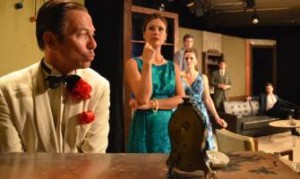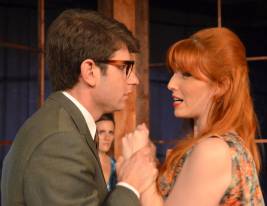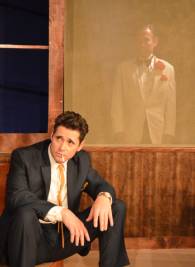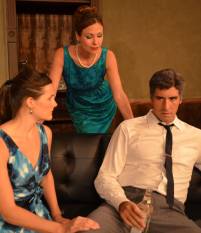RECOMMENDED
“Director’s concept” is a tricky business. When inspired, it can enhance a writer’s intentions and allow audiences to see a play or musical in new, exciting ways. When misguided, it can detract from a production’s effectiveness and distract an audience from a clear perception of what the playwright is trying to say. The latter proves to be the case in Crown City Theatre Company’s revival of J.B. Priestley’s 1932 drama Dangerous Corner, though fortunately not fatally so.
 Priestley’s 1932 play, the first of more than a dozen he was to write over the next two decades, centers around the question: Can a single chance remark provoke consequences that are quite literally a matter of life and death? How different would events be without that one casual slip of the tongue?
Priestley’s 1932 play, the first of more than a dozen he was to write over the next two decades, centers around the question: Can a single chance remark provoke consequences that are quite literally a matter of life and death? How different would events be without that one casual slip of the tongue?
A group of family members and friends have gathered at the country home of publisher Robert Chatfield and his wife Freda. Joining the Chatfields are Robert’s fellow publishing house directors Gordon (Freda’s brother) and Charles, along with Gordon’s wife Betty, Charles’ girlfriend Olwen (a secretary at the firm), and popular novelist Maud Mockridge.
Following a prophetic discussion of the expression “Let sleeping dogs lie,” the topic of conversation turns to the recent suicide of Robert’s younger brother Martin, apparently the result of guilt he felt over having stolen a large sum of money from the firm. When Freda offers Olwen a smoke from a musical cigarette box that had belonged to Martin, Olwen casually remarks that she has seen the box before.
Questions then begin to arise. How could she have seen it when Freda claims that this is the first time she has had it out? Does this mean that Freda was in fact not the last person to see Martin alive? Could it be that Martin didn’t actually steal the money, and if so, why did he tell two different stories about who he suspected of being the thief? And these questions are just the tip of the iceberg, leading to several shocking revelations and an evening that may well end in another tragedy.
 Don’t let Dangerous Corner’s age fool you. Unlike Hollywood movies of the ‘30s, ‘40s, and ‘50s, Broadway plays of the era were far more willing to deal with “taboo” themes like extramarital sexual relationships and same-sex longings, both of which figure prominently in Priestley’s script, and the twist which ends Dangerous Corner is so brilliant that were Priestley’s play a 2012 World Premiere, audiences would still be dazzled by the audacious originality of its final minutes.
Don’t let Dangerous Corner’s age fool you. Unlike Hollywood movies of the ‘30s, ‘40s, and ‘50s, Broadway plays of the era were far more willing to deal with “taboo” themes like extramarital sexual relationships and same-sex longings, both of which figure prominently in Priestley’s script, and the twist which ends Dangerous Corner is so brilliant that were Priestley’s play a 2012 World Premiere, audiences would still be dazzled by the audacious originality of its final minutes.
Director Gary Lamb transposes Dangerous Corner from the early 1930s to the early ‘60s, a time period in which Priestley’s stylized dialog still sounds absolutely right, and one which allows scenic designer Keiko Moreno to create a fabulous Mad Men-ready “retro-modern” living room and Tanya Apuya to design some gorgeous period suits and gowns for the cast. The more recent time frame contributes to the play’s relevance to contemporary audiences as well.
 Far less successful is the director’s decision to add Martin’s ghost to the list of dramatis personae, and not only that, but a musical ghost as well.
Far less successful is the director’s decision to add Martin’s ghost to the list of dramatis personae, and not only that, but a musical ghost as well.
On the plus side, the idea of having a physical manifestation of Martin’s ever-presence among the party guests is not without its merits, and the same can be said for having Martin set the mood for each act with a mid-20th Century standard, songs which actor/singer/pianist Cortés Alexander performs with Vegas-ready pizzazz.
Had director Lamb stopped at that, the concept might have worked, but it has been taken it too far, way too far, with Alexander inserting needlessly distracting song snippets as commentary on the action and at times even talking back to Priestley’s characters. Making matters worse is fact that Alexander, though a terrific entertainer, seems to have materialized from a Noel Coward comedy, and not the intense drama we are witnessing, his overly broad reactions far more suited to Blithe Spirit or the ‘30s film series Topper. As to why Martin keeps slipping in and out of the room even though the rest of the house remains empty, well that is anyone’s guess.
Fortunately, Priestley’s script remains strong despite spectral interference, the Crown City cast featuring a number of expert performances, most notably a sensational Libby Baker as Freda. Baker is so much the picture of ‘60s elegance and sophistication and she has so masterfully adopted the bearing and speech patterns of the era that her performance could be inserted into a Douglas Sirk melodrama and not be out of place. And the oh-so versatile Baker proves quite the vocalist as well, her Act Two duet of “Stormy Weather” opposite Alexander making that amply clear.
The dynamic Seth Peterson’s brings to Charles the excitement and electric presence of a young Jack Lemon, Jordan Wall hides his boyish good looks behind nerd glasses to create a powerfully tormented Gordon, and the always excellent Matthew J. Williamson creates a Robert so night-and-day different from his Scenie-winning performance as the titular Danny And The Deep Blue Sea that audiences will be marveling at his range. Tara Bopp (Olwen) and Rachel Amanda Bryant (Betty) are less successful at the heightened style of the era, but both have effective moments, Bopp in particular in a flashback scene opposite Alexander that would make a terrific Actors’ Showcase piece. Completing the cast is Carol Goans as a delightfully dry Miss Mockridge,
 Zad Potter’s dramatic lighting and a topnotch sound design help make Dangerous Corner one of the best looking and sounding productions I’ve seen at Crown City Theatre.
Zad Potter’s dramatic lighting and a topnotch sound design help make Dangerous Corner one of the best looking and sounding productions I’ve seen at Crown City Theatre.
I enjoyed Dangerous Corner, despite the intrusive presence of a ghost who would have been best left spoken about but not seen. J.B. Priestley wrote one doozy of a play, one which the majority of the Crown City cast perform quite splendidly. My recommendation: See the production, but do your best to ignore the ghost.
Crown City Theater, St. Matthew’s Church, 11031 Camarillo St., North Hollywood.
www.crowncitytheatre.com
–Steven Stanley
October 7, 2012
Photos: Keiko Moreno


 Since 2007, Steven Stanley's StageSceneLA.com has spotlighted the best in Southern California theater via reviews, interviews, and its annual StageSceneLA Scenies.
Since 2007, Steven Stanley's StageSceneLA.com has spotlighted the best in Southern California theater via reviews, interviews, and its annual StageSceneLA Scenies.







 COPYRIGHT 2024 STEVEN STANLEY :: DESIGN BY
COPYRIGHT 2024 STEVEN STANLEY :: DESIGN BY